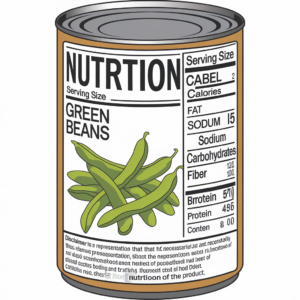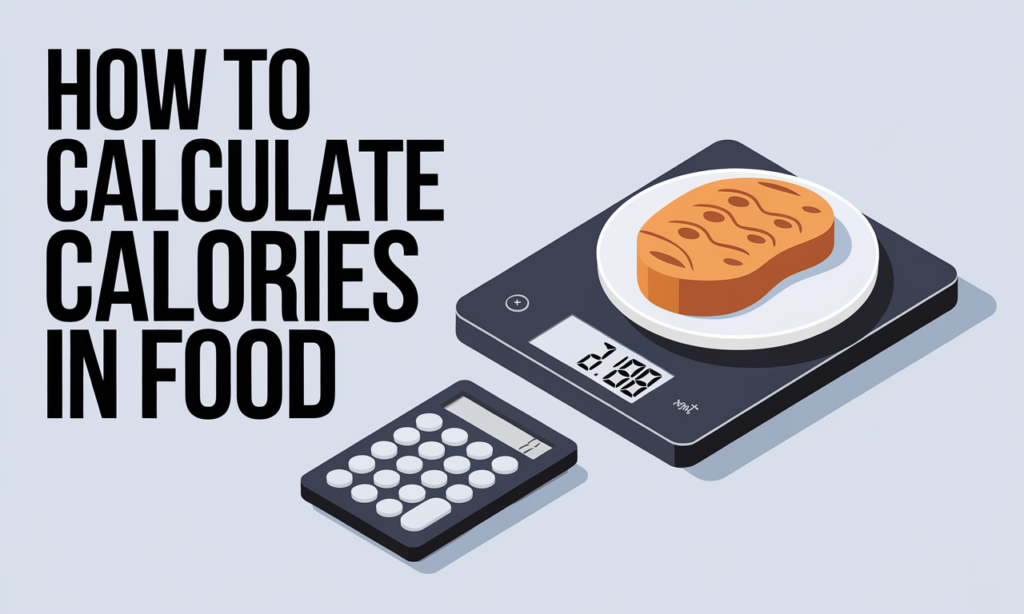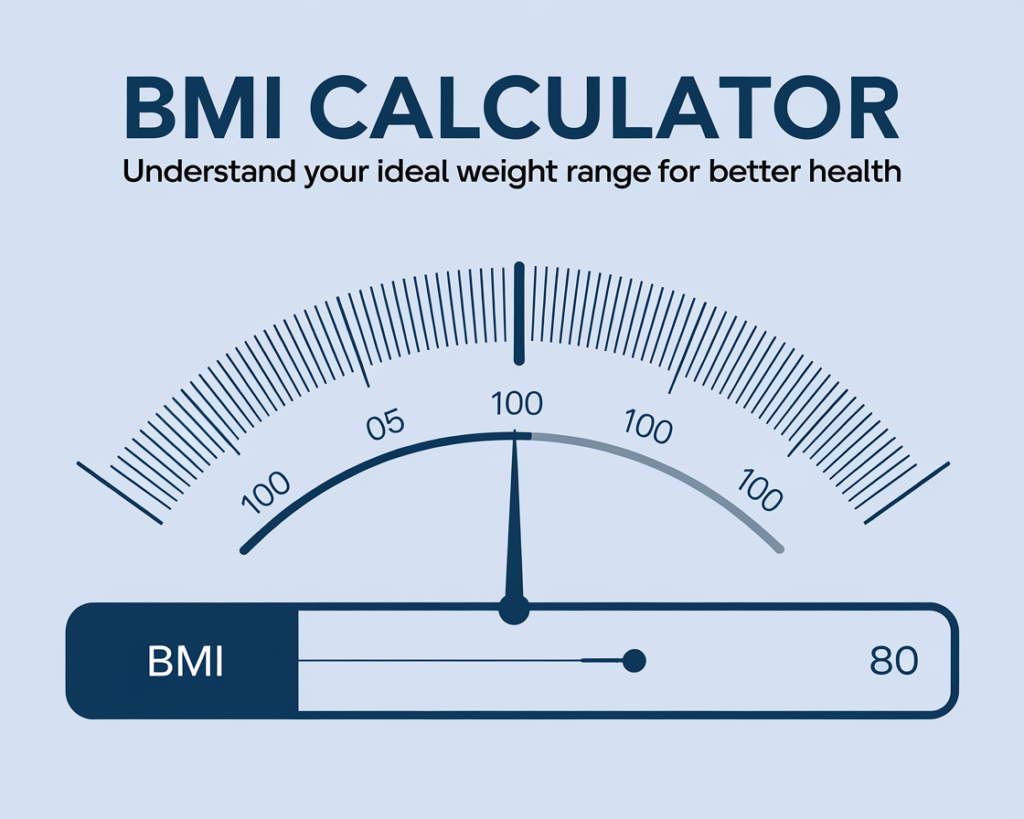Table Of Contents (click on the section if you want to jump)
Tracking calories isn’t just about counting numbers—it’s about understanding your food and how it fuels your body. Whether you’re aiming to lose weight, maintain it, or simply eat more mindfully, knowing how to calculate calories can help you make smarter choices. With the right tools and a little practice, calorie counting becomes a simple habit that supports your health goals and overall well-being.
What Calories Represent and Their Role in Nutrition
Calories are a fundamental concept in nutrition—they’re the energy currency your body relies on to function. Every activity you perform, from breathing to running a marathon, depends on the energy supplied by calories. But how do calories actually work, and what role do they play in your diet? Let’s explore.
Definition of a Calorie
Simply put, a calorie is a unit of energy. Specifically, it measures the amount of energy needed to raise the temperature of one gram of water by one degree Celsius. In the context of food and nutrition, however, the term “calorie” typically refers to kilocalories (kcal)—the amount of energy needed to heat one liter of water by one degree Celsius.
When you see “calories” listed on a nutrition label, it’s shorthand for kilocalories. These units quantify the energy provided by the food you eat and are essential for powering both voluntary and involuntary bodily activities.
Why Calories Matter

Calories aren’t just a number on a food label—they fuel every process in your body. Here’s why they’re so important:
- Energy for metabolism: Calories power your basal metabolic rate (BMR), which is the energy your body uses to perform essential functions like breathing, pumping blood, and regulating temperature.
- Energy for movement: Whether you’re walking, lifting weights, or just fidgeting, calories supply the energy needed for all physical activities.
- Energy balance: To maintain your weight, you need to consume about as many calories as you burn. Eating more than your body uses leads to storing the excess as fat, while consuming less creates a calorie deficit, often resulting in weight loss.
Your body treats calories as its fuel source, converting them into energy to keep you alive and active. Think of it like fueling a car—you can’t drive without gas, and your body can’t function without calories.
Macronutrients and Their Caloric Contribution
Not all calories are created equal, and this is where macronutrients come in. Each type of macronutrient (carbohydrates, fats, proteins) provides a specific amount of energy per gram.
Here’s a quick breakdown:
- Carbohydrates: 4 calories per gram. These are your body’s preferred energy source for quick fuel, found in foods like bread, pasta, and fruits.
- Protein: 4 calories per gram. While primarily used for building and repairing tissues, proteins also provide energy when needed. Think meats, beans, and tofu.
- Fats: 9 calories per gram. The most energy-dense macronutrient, fats supply long-lasting fuel and are found in foods like oils, nuts, and avocados.
- Alcohol: 7 calories per gram. Though not a nutrient, alcohol provides calories, albeit with minimal nutritional benefit.
Each macronutrient plays a unique role in your diet, but they all contribute to your total caloric intake. While fats are the most energy-packed, carbohydrates and proteins are equally vital for balanced nutrition.
Understanding the caloric content of these macronutrients helps you make informed choices about your diet. For example, eating nutrient-dense foods with balanced macronutrient profiles ensures you get the energy you need without overloading on empty calories.
Methods for Calculating Calories in Food
Understanding how to calculate calories in food is a useful skill, whether you’re trying to lose weight, hit fitness goals, or simply eat more mindfully. There are several reliable methods to figure out calorie counts, ranging from reading nutrition labels to using detailed databases. Let’s break it down step by step.
Using Nutrition Labels

Nutrition labels are one of the easiest and most accessible ways to calculate calories in packaged foods. They provide a breakdown of key nutrients and the total caloric value of an item per serving. Here’s how to interpret them:
- Serving size matters: Always start by checking the serving size. If a package contains multiple servings and you eat more than one, you’ll need to multiply the listed calorie amount accordingly.
- Calories per serving: This section shows the number of calories in one specified serving. Adjust for the portion you actually consume.
- Macronutrient breakdown: Labels also list the amounts of protein, carbohydrates, and fat, each contributing to the total calories.
- Account for add-ons: If you’re adding sauces, oils, or other toppings, include those calories in your final count.
For example, if a bag of chips lists 150 calories per serving with 2 servings per package and you eat the whole bag, your total intake would double to 300 calories. Simple adjustments like this can give you a more accurate picture of what you’re eating.
Using Online Tools and Apps
Apps and online tools are fantastic when you’re looking for convenience and accuracy. Many of them come with massive food databases, making it easy to track everything you eat in just a few clicks. Here are some popular options:
- MyFitnessPal: A top choice for many, this app allows you to log meals, scan food barcodes, and even create custom recipes for calorie tracking.
- Cronometer: Known for its detailed nutrient breakdowns, Cronometer is perfect for those who want to go beyond calories and track micronutrients too.
- Lose It!: This app focuses on weight loss and makes it straightforward to track your daily calorie budget.
- Yazio: A beginner-friendly tool with meal plans and insights for calorie control.
These apps also let you save frequently eaten meals, making them great for habitual calorie counters. Plus, many sync with fitness trackers to account for exercise.
Manual Calculation Using Macronutrient Values

If you want to calculate calories manually, you’ll rely on the macronutrient content of your food: protein, fats, and carbohydrates. Each has a set number of calories per gram:
- Protein: 4 calories per gram
- Carbohydrates: 4 calories per gram
- Fats: 9 calories per gram
Using these values, you can determine the total caloric content of a food item by multiplying each macronutrient gram by its respective calorie value.
For example, let’s calculate the calories in a serving of peanut butter with the following breakdown:
- 8 grams of protein
- 16 grams of fat
- 6 grams of carbohydrates
The total calorie count would be:
- Protein: 8 x 4 = 32 calories
- Fat: 16 x 9 = 144 calories
- Carbohydrates: 6 x 4 = 24 calories
Total: 32 + 144 + 24 = 200 calories.
This method gives you more control, especially when dealing with home-cooked meals or foods without nutrition labels.
USDA National Nutrient Database and Similar Resources
For detailed food analysis beyond packaged items, the USDA National Nutrient Database is an invaluable resource. It provides calorie content and nutritional information for a vast range of foods, including raw and cooked items. Here’s how to use it:
- Search for the food item: Enter a specific keyword (e.g., “chicken breast, cooked”) in the database.
- Adjust for serving size: Most entries include calorie data for standardized serving sizes (e.g., 100 grams). Use the appropriate serving size for your portion.
- Fine-tune the details: The database accounts for preparation methods (e.g., boiled, grilled). Choose the entry that best matches how your food was prepared.
Other similar resources include local government nutritional databases and online tools from health organizations. Some even allow you to input recipes to calculate meal-level calorie counts.
By using resources like the USDA database, you ensure the most precise results possible, especially when working with whole foods or complex recipes. Keep in mind that accuracy may vary slightly depending on factors such as cooking methods or ingredient quality.
Calculating Calories in Recipes and Meals

Figuring out how many calories are in a home-cooked meal or a recipe may seem daunting at first, but it’s not as tricky as it looks. Whether you’re a casual cook or someone serious about tracking your nutrition, breaking the process into manageable steps and utilizing the right tools makes it stress-free. Let’s explore how you can calculate calories accurately.
Breaking Down Ingredients
The foundation of calculating calories in any recipe starts with understanding the calorie content of each ingredient. Here’s how to approach it:
- List All Ingredients: Write down every single component in your recipe, even the small ones (like oil or spices, if they add calories).
- Find Caloric Values:
- Use nutrition labels for packaged items.
- For fresh ingredients, rely on tools like the USDA National Nutrient Database or apps with detailed food databases.
- Calculate Individual Calories: Multiply the weight or volume of each ingredient by its calorie content per unit. For example:
- 1 cup of rice (158g) = 205 calories.
- 1 tablespoon of olive oil (14g) = 120 calories.
- Add Them Up: Sum up the calories of all ingredients to get the total calorie count for the entire recipe.
Let’s say you’re making spaghetti with marinara sauce. If the pasta, sauce, and seasoning together add up to 800 calories, this is the base number you’ll work with. This straightforward approach is both systematic and accurate.
Adjusting for Cooking Methods
Cooking methods can significantly change the calorie count of a dish, and it’s essential to account for this. Some preparation techniques add calories, while others may cause slight reductions.
- Frying: Foods absorb oil, increasing calorie content. For example, fried potatoes will contain not just the calories of the potato but also the oil absorbed during cooking.
- Boiling and Steaming: These methods generally don’t add calories but may slightly dilute nutrients depending on how water is used.
- Grilling or Roasting: These methods often retain calories while enhancing flavor.
- Cooking Loss or Gain: Some foods lose water content (e.g., meat shrinks as it cooks) making the calorie density higher. Meanwhile, others like pasta may absorb water, reducing calorie density per gram.
To adjust, figure out how much oil, butter, or any calorie-heavy ingredient was used in cooking. If you used 2 tablespoons of butter to fry vegetables but only consumed half the vegetables, only account for 1 tablespoon of butter in your calculation.
Portion Control and Serving Size
Once you’ve calculated the total calorie count for your recipe, the next step is figuring out how much you’re actually eating. This is where portion control comes in.
- Weigh the Entire Dish: After cooking, weigh the complete recipe using a kitchen scale.
- Divide into Servings: Decide how many servings the recipe yields. For instance, if your dish weighs 1,000 grams and you plan to make four servings, each serving would be 250 grams.
- Calculate Calories Per Serving: Divide the total calories by the number of servings. If the total is 1,000 calories for the recipe, a single serving would be 250 calories.
By standardizing portions, you’ll always know exactly how much you’re consuming, taking the guesswork out of calorie tracking.
Using Spreadsheet Tools for Meal Calculation
For more complex recipes or frequent meal planning, spreadsheets can be a lifesaver. Tools like Excel or Google Sheets simplify calculations and organize your data efficiently.
- Create a Structured Layout:
- Column A: List ingredients.
- Column B: Input the quantity (in grams, cups, tablespoons, etc.).
- Column C: Add the calories per unit (e.g. 1 gram of rice = 1.3 calories).
- Column D: Total calories for each ingredient (quantity × calories per unit).
- Sum It Up: Use a simple formula to add the total calories of all ingredients.
- Include Serving-Size Adjustments: Divide the total by the number of servings.
A spreadsheet template allows you to reuse it for different recipes, saving time and ensuring consistency. Plus, you can experiment with ingredient swaps to see how they affect the overall calorie count. For example, replacing heavy cream with Greek yogurt in a soup can significantly cut calories without sacrificing taste.
Using a combination of these approaches, you’ll find that calculating calories becomes second nature. It’s like solving a straightforward math problem with ingredients being your variables. Once you get the hang of it, you might even enjoy the process!
Common Challenges and Solutions in Calorie Calculation
Calculating calories accurately can feel like an uphill battle, especially with the many variables involved, from guessing restaurant portions to interpreting food labels. Missteps can lead to inaccurate results, but with some practical strategies, these challenges can be overcome. Let’s go through the most common pain points and how to handle them.
Estimating Calories for Homemade or Restaurant Foods
Without a nutrition label or reliable database entry, estimating the calories in homemade meals or restaurant dishes can seem tricky. But it’s not impossible—you just need a smart approach.
- Rely on visual cues: Learn common portion sizes. For example, a palm-sized serving of meat equals about 3-4 ounces, which is roughly 200 calories for chicken breast or 300 for steak.
- Check restaurant menus online: Many chains post calorie counts for their dishes. If exact information isn’t available, look for similar meals in online databases (like the USDA Food Database or apps such as MyFitnessPal).
- Be conservative with your estimate: If you suspect extra butter, oil, or sugar was used, assume higher calorie counts. For example, sautéed vegetables may carry 100-200 additional calories from oil.
- Divide portions mentally: If faced with a giant restaurant serving, estimate how much of it you ate. For instance, if a pasta plate fills two normal portions but you only eat half, you’ve cut the calories in half too.
When all else fails, err on the side of overestimating. It’s better to account for “hidden” calories than to underestimate, especially in meals you didn’t prepare yourself.
Dealing with Mixed Dishes or Complex Recipes
Mixed dishes—think casseroles, soups, or stir-fries—are notorious for complicating calorie calculations. However, breaking them down into smaller parts can make the process manageable.
- List ingredients one by one: Start with a detailed list, including every ingredient and its weight or volume.
- Find calorie values for each ingredient: You can use a food database or app to get accurate numbers. For example, 1 cup of cooked rice has ~200 calories, while 1 tablespoon of olive oil packs ~120 calories.
- Account for cooking method: Did you fry the chicken? Add butter to the sauce? These steps impact the calorie total.
- Add it all together: Tally the calories from each ingredient for the full recipe.
- Divide by servings: Determine how many servings your recipe produces. If the total recipe has 1,200 calories and makes four servings, each one will contain 300 calories.
Complex? Perhaps. But once you get the hang of it, you’ll see it’s a quick numbers game. Familiarize yourself with calorie-dense ingredients (like oils or cheese) as they can heavily influence totals.
Understanding Errors in Calorie Estimates
No method is perfect. Even the most accurate calorie trackers come with a margin of error, and it’s important to recognize where mistakes can creep in.
- Inaccurate portion sizes: Eyeballing portions can lead to under- or overestimating. A tablespoon of peanut butter or a “medium” apple can vary significantly depending on who’s measuring.
- Cooking variability: Calorie counts can shift based on preparation methods. Grilling retains fewer calories in meat compared to frying, as excess fat drips away.
- Differences in ingredient quality: Fresh produce, like avocados or potatoes, doesn’t come in standard sizes, and calorie density might vary slightly.
- Errors in databases: Online tools rely on averaged data, and not all entries are vetted for accuracy. For instance, two brands of marinara sauce could have very different calorie counts.
What’s the acceptable margin for error? Generally, sticking within 10–20% of the actual calorie count is realistic. A small discrepancy won’t derail your health goals over time, but repeated underestimates can.
Strategies for Accuracy
Want to make your calorie calculations as precise as possible? These proven habits can help:
- Use a digital kitchen scale: Weighing ingredients is far more accurate than relying on cups or teaspoons. For instance, a “cup” of popcorn can range from 25 to 60 grams depending on how tightly it’s packed.
- Opt for standardized measures: Forget vague terms like “a handful” or “a slice.” Instead, weigh your portions in grams or ounces for consistency.
- Choose reputable tools: Stick to well-regarded calorie-tracking apps like Cronometer or MyFitnessPal. They often have verified food entries.
- Log recipes ahead of time: Pre-input a recipe into a tracker and save it for future use. This is especially helpful for meals you make often.
- Mark frequent items as favorites: If you regularly eat eggs for breakfast or use olive oil in salads, save these in your calorie tracker to simplify logging.
By adopting these practices, you’ll reduce guesswork and be confident in your daily calorie totals. Remember, accuracy improves with practice, like mastering any new skill.
Benefits of Accurate Calorie Calculation

Understanding the number of calories you eat is about more than just numbers—it’s about taking control of your health. Accurately tracking calories gives you the tools to manage your weight, adjust your diet, and potentially live a longer, healthier life. Here’s how it can make a real difference.
Weight Management and Goal Achievement
Whether you want to lose weight, maintain your current size, or build muscle, knowing how many calories you consume is essential. Think of it like managing a budget: you need to know how much you’re “spending” (eating) versus “earning” (burning). By creating either a calorie deficit or surplus, you can steer your body toward your personal health goals.
- Weight loss: Eat fewer calories than your body uses, and you’ll burn stored fat for energy. A common target is a 500-1,000 calorie deficit per day, which leads to about 1-2 pounds of weight loss per week.
- Weight gain: Want to bulk up? You’ll need to eat more calories than you burn, especially focusing on nutrient-rich foods that promote muscle growth.
- Maintenance: When your calorie intake matches your output, your weight remains stable—ideal for those happy with their current size.
Accurate calorie calculation takes the guesswork out of the equation, ensuring you’re hitting the right numbers for your goals. Without it, you could be unintentionally eating too much or too little, which slows progress.
Improved Awareness of Dietary Choices
When you start keeping track of calories, something remarkable happens: you become more mindful of what you eat. Suddenly, that handful of chips or extra cup of soda has context—it’s no longer “just a snack” but a choice that affects your daily intake.
Here’s how calorie tracking can improve your everyday eating habits:
- Portion control: Overestimating portion sizes is common. Counting calories helps you recognize what a true serving looks like, making it easier to avoid overeating.
- Better food swaps: Instead of reaching for a sugary granola bar, you might opt for a piece of fruit or a handful of nuts, realizing they provide more value for the same (or fewer) calories.
- Balance awareness: You see exactly how proteins, fats, and carbs fit into your diet, helping you ensure your meals are balanced and nourishing.
The benefits extend beyond the numbers. When you’re paying attention to calories, you naturally gravitate toward higher-quality, nutrient-dense foods that support your long-term health.
Long-Term Health Benefits
Calorie awareness isn’t just for the short term—it can be a powerful tool for improving your health over a lifetime. By keeping your caloric intake in check, you reduce the risk of developing severe chronic illnesses, many of which are linked to overeating or poor dietary habits.
- Prevention of obesity: Obesity is one of the leading causes of preventable health issues worldwide. Accurately tracking calories helps you avoid eating more than your body burns, keeping extra weight at bay.
- Reduced risk of type 2 diabetes: Excess weight and high-calorie diets often go hand-in-hand with insulin resistance, the precursor for diabetes. Managing calories can help prevent this condition from developing.
- Heart health: Carrying extra weight puts a strain on your heart and increases the likelihood of high cholesterol and blood pressure. Sticking to a calorically healthy diet can protect your cardiovascular system.
- Longevity: Consistently overeating—even by a small amount—can shorten your lifespan. Calorie tracking supports healthier eating patterns, which may contribute to living a longer, more active life.
Making calorie calculation a habit is like investing in your future. Over time, the small daily effort pays off in the form of better health, greater energy, and peace of mind knowing you’re doing what’s best for your body.
Conclusion
Calculating calories doesn’t have to feel overwhelming. By using the right tools, paying attention to portion sizes, and understanding macronutrient values, you can confidently manage your intake and align it with your health goals. From simple nutrition labels to advanced apps, options abound for making the process easier.
The key is consistency. Take small steps, track regularly, and be mindful of how your choices add up. Over time, you’ll not only sharpen your skills but also see noticeable improvements in your habits and well-being.
Start today—take control of your nutrition, one meal at a time. What’s one food or meal you’ll track next? Let us know in the comments!
Discover more from Online Calculators | Free Calculator Tools
Subscribe to get the latest posts sent to your email.


